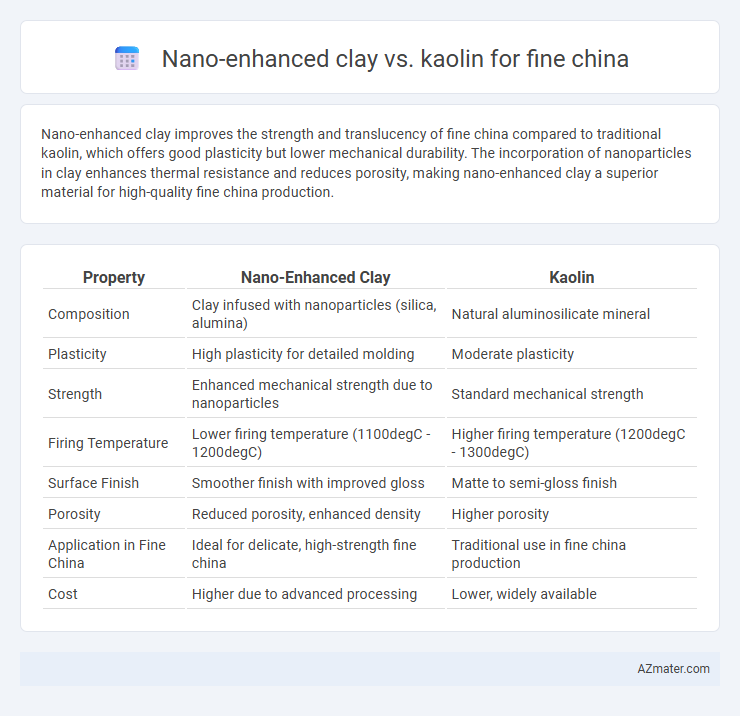Nano-enhanced clay improves the strength and translucency of fine china compared to traditional kaolin, which offers good plasticity but lower mechanical durability. The incorporation of nanoparticles in clay enhances thermal resistance and reduces porosity, making nano-enhanced clay a superior material for high-quality fine china production.
Table of Comparison
| Property | Nano-Enhanced Clay | Kaolin |
|---|---|---|
| Composition | Clay infused with nanoparticles (silica, alumina) | Natural aluminosilicate mineral |
| Plasticity | High plasticity for detailed molding | Moderate plasticity |
| Strength | Enhanced mechanical strength due to nanoparticles | Standard mechanical strength |
| Firing Temperature | Lower firing temperature (1100degC - 1200degC) | Higher firing temperature (1200degC - 1300degC) |
| Surface Finish | Smoother finish with improved gloss | Matte to semi-gloss finish |
| Porosity | Reduced porosity, enhanced density | Higher porosity |
| Application in Fine China | Ideal for delicate, high-strength fine china | Traditional use in fine china production |
| Cost | Higher due to advanced processing | Lower, widely available |
Introduction to Fine China Raw Materials
Fine china raw materials primarily consist of kaolin, a pure white clay crucial for its plasticity and whiteness, delivering the smooth texture and translucency desired in high-quality porcelain. Nano-enhanced clay incorporates nanotechnology to modify particle size and improve mechanical strength, thermal resistance, and surface smoothness, surpassing traditional kaolin properties. This innovation enhances fine china's durability and appearance while maintaining the essential characteristics provided by conventional kaolin-based formulations.
Overview of Nano-Enhanced Clay
Nano-enhanced clay incorporates nanoparticles to improve the physical properties of fine china, offering superior strength, durability, and whiteness compared to traditional kaolin. These nanoscale additives enhance the clay's plasticity and firing behavior, resulting in finer texture and reduced porosity. By optimizing structural integrity at the microscopic level, nano-enhanced clay elevates the quality and performance of fine china products.
Properties of Traditional Kaolin
Traditional Kaolin, a key component in fine china, exhibits high purity, excellent whiteness, and a smooth, plastic texture that enhances workability and translucency. Its fine particle size ensures superior moldability and contributes to the strength and durability of the final porcelain product. Compared to nano-enhanced clay, traditional kaolin maintains consistent thermal stability and chemical inertness, crucial for preserving the elegant finish and longevity of fine china.
Comparative Chemical Composition
Nano-enhanced clay contains engineered nanoparticles that improve plasticity and firing strength by modifying silica and alumina ratios, whereas Kaolin primarily consists of hydrated aluminum silicate with a higher purity and less structural variance. The innovative addition of nanoscale particles in Nano-enhanced clay increases surface area and reactivity, enhancing vitrification and translucency, while Kaolin's stable crystalline structure offers excellent whiteness and opacity. Fine china benefits from Nano-enhanced clay's balanced chemical composition, which optimizes durability and translucency compared to the traditional consistency of Kaolin.
Impact on Workability and Shaping
Nano-enhanced clay significantly improves workability and shaping in fine china production by increasing plasticity and reducing drying time, allowing for more precise and intricate designs. Kaolin, while providing excellent whiteness and translucency, tends to be less plastic and can result in higher shrinkage and brittleness during shaping. The incorporation of nanoparticle additives enhances the mechanical strength and flexibility of kaolin-based clay, facilitating smoother molding and reducing defects in delicate fine china pieces.
Firing Performance and Thermal Stability
Nano-enhanced clay exhibits superior firing performance and thermal stability compared to traditional kaolin when used in fine china production. The incorporation of nanoparticles improves the sintering process, resulting in higher density and reduced porosity, which enhances mechanical strength and translucency. Enhanced thermal stability minimizes thermal expansion and cracking risks during high-temperature firing, ensuring fine china retains its shape and durability.
Effects on Strength and Durability
Nano-enhanced clay significantly improves the strength and durability of fine china by reinforcing the ceramic matrix at the nanoscale, resulting in higher fracture resistance and reduced porosity compared to traditional Kaolin. Kaolin, while valued for its whiteness and plasticity, generally offers less mechanical strength and is more prone to chipping under stress. Incorporating nano-clay particles enhances the fine china's ability to withstand thermal shock and mechanical wear, making it superior in long-term durability.
Aesthetic Qualities and Finish
Nano-enhanced clay offers superior translucency and a smoother surface finish compared to traditional kaolin, enhancing the delicate appearance of fine china. Its nanostructured particles improve light refraction, resulting in a lustrous sheen and more vibrant color retention. Kaolin, while providing a classic matte texture and excellent whiteness, tends to produce a slightly coarser finish that lacks the refined gloss achievable with nano-enhanced materials.
Environmental and Economic Considerations
Nano-enhanced clay improves fine china production by reducing raw material consumption and energy use, resulting in lower carbon emissions and waste generation compared to traditional Kaolin. Its higher strength and plasticity decrease firing temperatures and cycle times, cutting operational costs and enhancing sustainability in manufacturing processes. Economically, despite higher initial costs, nano-enhanced clay offers long-term savings through reduced material waste and improved product quality, aligning with eco-friendly industry demands.
Future Trends in Fine China Material Innovation
Nano-enhanced clay offers superior strength and translucency compared to traditional Kaolin, enabling manufacturers to create finer, more durable fine china with enhanced aesthetic appeal. Ongoing advancements in nanotechnology are expected to improve thermal resistance and reduce material weight, addressing demands for both elegance and practicality. Future trends will likely emphasize eco-friendly production methods combining nano-enhanced clays with sustainable raw materials, driving innovation in the fine china industry.

Infographic: Nano-enhanced clay vs Kaolin for Fine china
 azmater.com
azmater.com